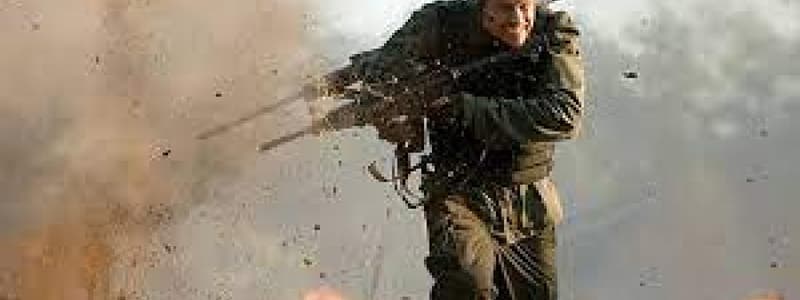Podcast
Questions and Answers
What is the definition of Force Protection (FP)?
What is the definition of Force Protection (FP)?
- Protective measures taken to mitigate hostile actions in specific areas or against a specific population (correct)
- Protection from observation to prevent direct observation from a threat
- Protection from firearms and other hostile weapons
- A team of law enforcement officers tasked with locating suspects and neutralizing threats
What is an Improvised Explosive Device (IED)?
What is an Improvised Explosive Device (IED)?
- A device placed or fabricated in an improvised manner incorporating destructive, lethal, noxious, pyrotechnic, or incendiary chemicals and designed to destroy, incapacitate, harass, or distract (correct)
- A team of personnel used to move the injured/uninjured to an area of safety
- A coordinated and concurrent attack on multiple locations involving multiple attackers
- Preventive measures taken to mitigate hostile actions in specific areas or against a specific population
What is the definition of Concealment?
What is the definition of Concealment?
- The protection from firearms or other hostile weapons
- A coordinated and concurrent attack on multiple locations involving multiple attackers
- The protection from observation (correct)
- A device placed or fabricated in an improvised manner incorporating destructive, lethal, noxious, pyrotechnic, or incendiary chemicals
What does a Contact Team/Law Enforcement Entry Team do?
What does a Contact Team/Law Enforcement Entry Team do?
What is the definition of an Active Assailant(s) (AA)?
What is the definition of an Active Assailant(s) (AA)?
What does Active Shooter Hostile Event Response (ASHER) refer to?
What does Active Shooter Hostile Event Response (ASHER) refer to?
What is the primary role of law enforcement officers (LEO) in the RTF?
What is the primary role of law enforcement officers (LEO) in the RTF?
What is the main purpose of a Threat based care?
What is the main purpose of a Threat based care?
What could be a potential task for the RTF in the warm zone?
What could be a potential task for the RTF in the warm zone?
What is the definition of the Hot Zone in the context of an ASHER incident?
What is the definition of the Hot Zone in the context of an ASHER incident?
Where are Rescue Task Force’s (RTF’s) advised NOT to be deployed in an ASHER incident?
Where are Rescue Task Force’s (RTF’s) advised NOT to be deployed in an ASHER incident?
What is the characteristic of the Cold Zone in the context of an ASHER incident?
What is the characteristic of the Cold Zone in the context of an ASHER incident?
What is the main purpose of a Threat based care?
What is the main purpose of a Threat based care?
What is the primary difference between an Active Assailant and an Active Shooter?
What is the primary difference between an Active Assailant and an Active Shooter?
What is the purpose of Ballistic Protection Equipment (BPE)?
What is the purpose of Ballistic Protection Equipment (BPE)?
What is the function of a Casualty Collection Point (CCP) in the context of an ASHER incident?
What is the function of a Casualty Collection Point (CCP) in the context of an ASHER incident?
In the context of an ASHER incident, what is the primary authority structure where the role of incident commander is shared by individuals from all responding organizations?
In the context of an ASHER incident, what is the primary authority structure where the role of incident commander is shared by individuals from all responding organizations?
Where is the field location at which the primary tactical level, on scene unified incident command functions are performed in an ASHER incident?
Where is the field location at which the primary tactical level, on scene unified incident command functions are performed in an ASHER incident?
What type of incident involves a threat of violence or current violence taking place in the context of an ASHER incident?
What type of incident involves a threat of violence or current violence taking place in the context of an ASHER incident?
Where is an area with the potential for a hazard or an indirect threat to life located in an ASHER incident?
Where is an area with the potential for a hazard or an indirect threat to life located in an ASHER incident?
What is the primary operational area with a potential threat to personal safety or health in the context of an ASHER incident?
What is the primary operational area with a potential threat to personal safety or health in the context of an ASHER incident?
Where is the zone established and secured by Law Enforcement, and only essential units will be given authority and clear direction to operate in, in an ASHER incident?
Where is the zone established and secured by Law Enforcement, and only essential units will be given authority and clear direction to operate in, in an ASHER incident?
In the context of an ASHER incident, where may Rescue Teams be able to enter and remove victims, and a rapid direct medical intervention may be performed if deemed warranted?
In the context of an ASHER incident, where may Rescue Teams be able to enter and remove victims, and a rapid direct medical intervention may be performed if deemed warranted?
"Personnel shall be escorted by a Law Enforcement security detail at all times while in this area" refers to which area in an ASHER incident?
"Personnel shall be escorted by a Law Enforcement security detail at all times while in this area" refers to which area in an ASHER incident?
What is the main role of the Contact Team/Law Enforcement Entry Team during an ASHER incident?
What is the main role of the Contact Team/Law Enforcement Entry Team during an ASHER incident?
What is the purpose of Concealment in an ASHER incident?
What is the purpose of Concealment in an ASHER incident?
What is the Unified Command structure in an ASHER incident?
What is the Unified Command structure in an ASHER incident?
What characterizes the Hot Zone in the context of an ASHER incident?
What characterizes the Hot Zone in the context of an ASHER incident?
What is the primary purpose of Ballistic Protective Equipment (BPE) in an ASHER incident?
What is the primary purpose of Ballistic Protective Equipment (BPE) in an ASHER incident?
What is the primary role of the Extraction Team/Litter Bearers in an ASHER incident?
What is the primary role of the Extraction Team/Litter Bearers in an ASHER incident?
What is the main task of the Rescue Task Force (RTF) in the Warm Zone during an ASHER incident?
What is the main task of the Rescue Task Force (RTF) in the Warm Zone during an ASHER incident?
What does an Improvised Explosive Device (IED) refer to in the context of ASHER incidents?
What does an Improvised Explosive Device (IED) refer to in the context of ASHER incidents?
What is the purpose of Force Protection (FP) in specific areas or against a specific population during an ASHER incident?
What is the purpose of Force Protection (FP) in specific areas or against a specific population during an ASHER incident?
What is the main content of an After Action Report (AAR) prepared after an ASHER incident?
What is the main content of an After Action Report (AAR) prepared after an ASHER incident?
What is the Incident Commander (IC) responsible for?
What is the Incident Commander (IC) responsible for?
What does S.A.L.T. stand for in the context of AS/MCIs?
What does S.A.L.T. stand for in the context of AS/MCIs?
What is the primary purpose of a Contact Team/Contact Officer in an AS/MCI?
What is the primary purpose of a Contact Team/Contact Officer in an AS/MCI?
What is the primary role of law enforcement officers (LEO) in the Rescue Task Force (RTF)?
What is the primary role of law enforcement officers (LEO) in the Rescue Task Force (RTF)?
What does T.H.R.E.A.T. represent in the context of AS/MCIs?
What does T.H.R.E.A.T. represent in the context of AS/MCIs?
What is the definition of Cover in the context of law enforcement operations?
What is the definition of Cover in the context of law enforcement operations?
What is the main purpose of an Emergency Operations Plan (EOP) in AS/MCIs?
What is the main purpose of an Emergency Operations Plan (EOP) in AS/MCIs?
What does Mutual Aid involve in the context of AS/MCIs?
What does Mutual Aid involve in the context of AS/MCIs?
What does Secured refer to in the context of AS/MCIs?
What does Secured refer to in the context of AS/MCIs?
What is the definition of a Hazardous Device?
What is the definition of a Hazardous Device?
Flashcards are hidden until you start studying
Study Notes
- Competence: Refers to having the necessary knowledge, skills, and judgment for indicated objectives.
- Concealment: Objects that offer protection from observation in the context of law enforcement.
- Contact Team/Contact Officer: A group of law enforcement members responsible for locating and stopping an active killer. Contact officer is an individual in search, while contact team consists of multiple officers.
- Containment: Law enforcement term for establishing a perimeter around a target location to control and isolate suspect movement.
- Control Zones: Areas within an established perimeter in AS/MCIs, designated based on safety and hazard degree.
- Cover: Objects or locations providing protection from direct gunfire.
- Emergency Operations Plan (EOP): Framework for command and control during AS/MCIs, coordinating activities of police, fire rescue, and other supporting agencies.
- Force Protection (FP): Preventive measures against hostile actions in specific areas or against a population, protecting civilians and unarmed responders.
- Hazardous Device: Explosive devices made in an improvised or modified manner, designed to destroy, incapacitate, etc.
- Hot (Red) Zone: Operational area with a direct and immediate threat to personal safety, only SWAT Tactical Medics and Law Enforcement Officers are authorized to operate, victims are removed into a warm (yellow) zone.
- Improvised Explosive Device (IED): Explosive device constructed using unconventional methods and materials.
- Incident Commander (IC): Individual responsible for managing all incident activities.
- Incident Command Post (ICP): A stationary work location for IC or a Unified Command for command and control.
- Incident Management System (IMS): Process defining roles, responsibilities, and operating procedures for managing and directing emergency operations.
- Mutual Aid: Agencies and/or jurisdictions assisting each other by providing personnel, equipment, and expertise.
- Notification and Reunification Center: Secure facility used to provide information and help reunite missing or unaccounted for persons with their loved ones.
- Protected Corridor Operations: Law enforcement forming a secure path for fire and EMS responders to care for and extract victims.
- Rescue Task Force: Minimum number of law enforcement and fire personnel needed to provide security and treatment to victims in the warm zone.
- Rescue Team: Designated group of law enforcement officers not involved with contact team, assisting with victim removal and coordinating with fire rescue personnel.
- Risk vs. Benefit: Decision-making formula for weighing risks against potential gains.
- S.A.L.T.: Mass casualty triage algorithm for sorting, assessing, performing lifesaving interventions, and treating/transporting victims.
- Secured: Geographic location where law enforcement has found no obvious threat and maintains a constant presence.
- Staging: Function where resources are assembled and await instructions or assignments, ready for immediate response.
- Strong Hold: Defensible area inside a structure, typically having doorways and access covered by armed protection.
- Third party complainants: Complaints from someone other than the directly involved person (e.g., reporting a family member's social media post about self-harm).
- T.H.R.E.A.T.: Acronym representing Threat Suppression, Hemorrhage Control, Rapid Extraction to Safety, Assessment by Medical Providers, and Transport to Definitive Care.
- Threat-Based Care: Medical care determined by present conditions.
- Treatment Area: Application of treatment for victims after extraction and sorting, before loading for transport to definitive care.
- Triage: Sifting and sorting process occurring in multiple phases, constant and re-occurring.
Studying That Suits You
Use AI to generate personalized quizzes and flashcards to suit your learning preferences.




